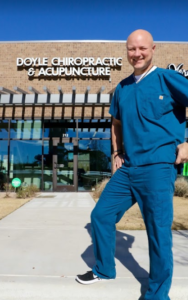While we know this is a difficult time for many, being stuck at home can be a great opportunity to practice self-care. If you’re someone who suffers from back pain, take this time to learn some simple and effective ways to relieve it.
In this blog, Dr. Cody Doyle discusses the best back and shoulder stretches, how to sit and sleep properly, and exercises to improve your back health.
Back and Shoulder Stretches
The proper stretches can relieve pain by helping you maintain flexibility, promote range of motion, and improve blood flow. Choose a few of the following stretches to complete daily and spend 30 seconds on each stretch.
In this list, we’ll tell you the name of the stretch, what type of pain it helps with, and the steps to complete it.
1. Neck side bend and rotation: neck and upper back
- Sit or stand facing forward
- Tilt your head to the right
- Hold for 10 seconds
- Roll your head to the left slowly
- When you reach your left shoulder, hold for ten seconds
- Roll back to the right shoulder
Repeat this stretch two to three times.
2. Shoulder roll: shoulders and upper back
- Stand up straight
- Place your arms at your sides
- Roll your shoulders from the back to the front in a circular motion five times
Repeat two to three times.
3. Overhead arm reach: shoulders and upper back
- Sit up straight on a chair
- Face forward
- Place your feet flat on the ground
- Put your right arm straight up
- Reach to the left
- Bend at the torso—you should feel a stretch in your shoulder and middle of your back
- Return to the original position
Repeat five times then switch to your opposite arm.
4. Chair rotation: upper, mid, and lower back
- Sit sideways in a chair
- Place your feet directly in front of you on the ground
- Rotate your torso to the right and reach for the back of the chair
- For ten seconds, hold yourself in that position
- Use your arms to rotate your torso further
Repeat three times for each side.
5. Cat cow: mid and lower back
- Get down on your hands and knees
- Place your palms right under your shoulders
- Place your knees directly under your hips
- Inhale and pull your pelvis in while rounding out your mid back
- Pull your navel into your spine
- Drop your head
- Hold for three to five seconds
- Breathe out and return to the original position
- Tilt your face upward
- Allow your back to sink towards the floor
- Hold for three to five seconds
Repeat this stretch five times.
Other Helpful Stretches
The Cleveland Clinic offers short videos that show what each of these stretches looks like. They also include several other stretches, including:
- Pec stretch
- Child’s pose
- Knee to chest
- Butterfly
- Thoracic extension
Best Sitting and Sleeping Practices
Lower back pain makes everything in life more difficult—even sitting and sleeping! It may take between 10 and 20 days for your back to heal, but learning how to sit and sleep properly will certainly help ease the pain.
Sitting
To reduce the pain in your lower back, follow these guidelines:
- Sit as little as possible and only for 10 to 15 minutes at a time
- Use a pillow or rolled-up towel for back support while sitting
- Place your feet directly on the floor in front of you (use a stool if necessary)
- Sit in a firm chair with armrests
- Adjust your chair height
- When turning, turn your entire body
Sleeping
Good, restful sleep is essential to living a healthy life. It’s also a great time to let your back muscles rest and reset. These five tips will help support your back and give you better sleep.
-
Find the right position.
There are ways to support your back without having to completely change your sleeping position. If you’re a side-sleeper, slightly bend your legs at the knees and pull them towards your chest, then place a pillow between your legs.
Those who sleep on their backs should put a pillow under their knees and head. For additional support, roll up a small towel and place it under the back.
Sleeping on your stomach is one of the worst positions for your back. However, you can lessen the pressure on your lower back by placing a pillow under your lower abdomen and pelvis. Sleep with a pillow under your head as long as it doesn’t cause more strain on your back.
-
Get a new mattress.
Mattresses today come in all levels of comfort. It can be difficult to decide whether a firm mattress or soft mattress is better for your back, but the best thing to do it try them out. Pay attention to how your back feels after you’ve slept in a hotel bed or at someone else’s house.
Placing your mattress on the floor will give it more support than when it is sitting on a box spring. Try this for a couple of nights to see how the extra support affects your pain. You can make your mattress softer by adding a mattress topper. As a bonus, you’ll avoid the expenses of buying a brand-new mattress!
Talk to a chiropractor to help you determine whether a firm or soft mattress is best for you.
-
Be careful when getting in and out of bed.
So many people throw their backs out while getting in and out of bed. To avoid further pain in your back, make slow movements and avoid bending at the waist.
When getting into bed, sit on the edge of the bed, then as you lie down on your side, bring your legs into the bed. Once your settled, adjust to the proper sleeping position.
-
Exercise your core.
Strengthening the muscles in your abdomen, hips, pelvis, and lower back eases back pain and lowers the risk of muscle spasms. We’ll discuss some of the best exercises to relieve back pain in the next section.
-
Do yoga before bed
Yoga doesn’t just reduce your back pain, it also lowers stress levels and encourages better sleep. Your chiropractor can help you decide which yoga stretches and poses are best for your back pain.
Back, Shoulder, and Neck Exercises
Exercising the muscles in your back, shoulders, and neck is essential to reducing and preventing further pain. Complete these seven exercises at least three times a week and always after stretching.
- Row for upper back
- Face pull for upper back and shoulder
- Scapular squeeze for upper back and shoulder
- Wall angles for neck, shoulders, and upper back
- Reverse dumbbell fly for shoulders and upper back
- Lat pulldown for shoulders and upper back
- Superman for mid and lower back
Click here for instructions and short videos on how to complete these exercises.
Talk to a Chiropractor
When it’s possible to visit with a chiropractor, schedule an initial consultation. Chiropractors like Dr. Doyle are passionate about helping their patients achieve total wellness through natural and conservative treatments.
To meet with our Roanoke, TX chiropractor, call (817) 767-5430 today.


